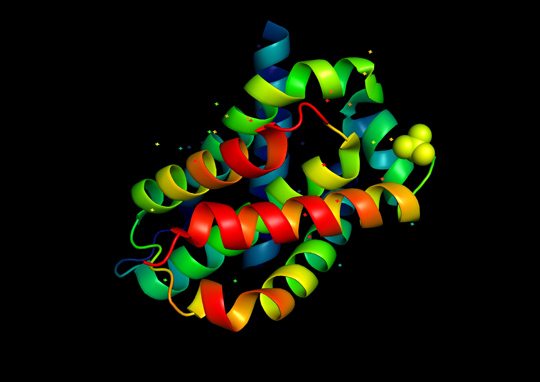The Centenary of Giant Molecules
Freiburg, Sep 25, 2020
What is all this talk about very large molecules that apparently make up natural rubber? In 1920 a publication by Hermann Staudinger, subsequently Nobel laureate for Chemistry and at that time a professor at the Federal Institute of Technology (ETH) Zurich, turned the scientific world on its head. Although it was known that small molecules combine into large aggregates without a permanent atomic bond, a colleague advised Staudinger not to waste his time on the chemistry of lubricants. Yet the nay-sayer was massively wrong: a hundred years after their discovery ‘giant molecules’ are more important than ever. And the University of Freiburg is a significant contributor: its Institute for Macromolecular Chemistry was founded by Hermann Staudinger, the father of polymer science, as the first European research center in 1940.
 A 3D view of this molecule looks rather like a birthday streamer: Hermann Staudinger discovered macromolecules in 1920. Photo: sergunt/stock.adobe.com
A 3D view of this molecule looks rather like a birthday streamer: Hermann Staudinger discovered macromolecules in 1920. Photo: sergunt/stock.adobe.com
Without Hermann Staudinger’s discovery there might not be as much plastic in the sea. “But without polymers there would also be no more elephants, as ivory has not been used for billiard balls, for example, for a long time,” explains Prof. Dr. Rolf Mülhaupt, director of the institute, and billiard balls are only one of many examples of the beneficial effect of plastics as a product of polymer research. “The problems that arise from it are to do with humans, not with the material.” Initially plastic was used as a substitute material. For example, in the First World War it was no longer possible to ship rubber to Germany because of the sea blockade. The Kaiser called for synthetic rubber for military vehicles. Later, with growing populations, demand for ivory and silk could no longer be met from natural sources alone. As a researcher Staudinger even experimented in developing a synthetic pepper flavoring and the industrially reproducible flavor of roasted coffee.
Originally based in the tradition of organic chemistry, Staudinger chanced upon giant molecules in nature: thousands of small molecular units linked together like pearls on a string. By measuring viscosity and experimenting with hydrogenation he proved that when hydrogen was added to the macromolecules they survived and did not disintegrate back into small molecular units, as his critics claimed. However simply benefiting from nature was not enough for later researchers. They wanted to create materials with special characteristics: for example cellulose is a natural product based on polymers. “But you can’t injection mold cellulose,” says Mülhaupt. The addition of camphor gave rise to celluloid, which among other things led to the invention of cinema and provided children with much-loved dolls.
Hard as steel and supple, dense and permeable
Rolf Mülhaupt describes today’s rapid developments in polymer research as down to ‘molecular design’. “We can make plastic out of everything today.” Depending on the molecular architecture and characteristics of the catalyst used in an experiment, the material can become hard as steel or supple as rubber, insulating or conductive, dense or permeable. Cheap substitutes for scarce goods gave way to modern materials that can be found almost everywhere today: from lightweight structures (such as car parts), textiles, ‘rubber’, circuit boards and food packaging to dental fillings, artificial hips or kidneys or membranes for desalination.
From 15 million tons of polymers worldwide in 1966, production increased tenfold to more than 150 million tons worldwide in 1996. Mülhaupt praises the “attractive cost-benefit ratio, energy-saving production and ease of molding.” While 200 kilograms of waste, including solvents that had to be recycled, arose in the production of one ton of hydrocarbon materials such as polyethylene or polypropylene in 1960, today solvents are no longer used and “there is zero waste”, the expert asserts. His work group is developing single-origin composite materials for the recycling economy that can be used for instance in 3D printing.
 Once he is an emeritus, Rolf Mülhaupt plans to continue building the alliance of fundamental research and product development. Photo: Löffler Ringfoto
Once he is an emeritus, Rolf Mülhaupt plans to continue building the alliance of fundamental research and product development. Photo: Löffler Ringfoto
‘Independence Day’ in October
The chemist says that “application-driven fundamental research” is essential to any progress. Since Freiburg did not offer technical chemistry, Mülhaupt relocated to write his dissertation at ETH Zurich. While there he learned the technical process for synthesizing polymers, and following periods at companies in Switzerland and the USA he knows how industry works. So when the Freiburg Materials Research Center (FMF) was established in 1989 there was no stopping Rolf Mülhaupt. The FMF brings researchers from chemistry, pharmaceutics, medicine, biology and environmental sciences together with industry to work on new materials. Mülhaupt became professor of Macromolecular Chemistry and director of the institute, and until recently he was executive director of the FMF. Bio-inspired materials research, at the cutting-edge of the search for renewable and biofunctional materials modeled on nature, is becoming increasingly important, and it is led by the Freiburg Center for Interactive Materials and Bioinspired Technologies (FIT)) and the Living, Adaptive and Energy-autonomous Materials Systems (livMatS) Cluster of Excellence.
On 1st October 2020 Rolf Mülhaupt becomes an emeritus, and he is looking forward to his ‘Independence Day’. As the owner of numerous patents he will be making use of his many corporate contacts, in order to continue and strengthen the fruitful alliance of fundamental research and product development – free of any higher education obligations.
Anita Rüffer
Article on Rolf Mülhaupt’s research in uni’knowledge magazine

